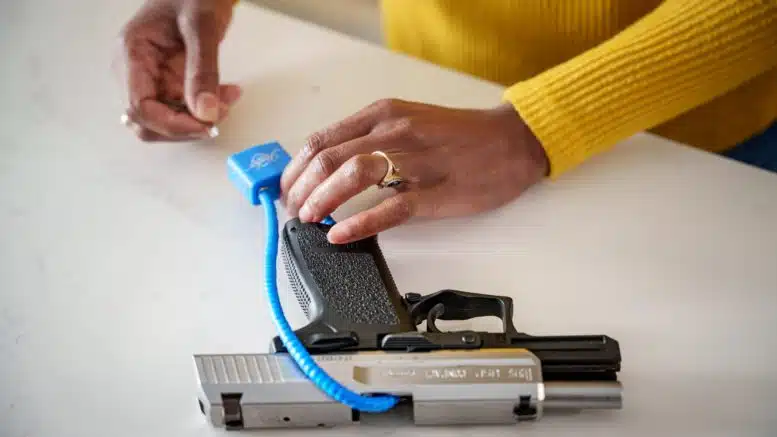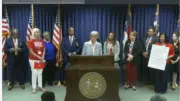CONTENT WARNING: This article references suicide. Please take caution when reading. If you need immediate mental health support, please call or text 988. Consult this page for more resources.
By Jennifer Fernandez
There’s a lot seared into Baker Burleson’s memory from the night in late 2021 when he took his son, William, to the emergency room for a mental health crisis. One thing his son said stands out:
“I tried to get one of your guns today.”
“The idea that he had gone from the point of (suicide) ideation to planning, that he had gone into my closet and explored my shotgun safe and tried to find a way to get into it, made it very real and made me very, very afraid for my son,” Burleson said earlier this month during the Oct. 4 kickoff for a series of webinars exploring issues facing North Carolina’s youth. This first webinar explored how firearm safety measures can help curb youth suicides.
On that December night nearly two years ago in the Burlesons’ Charlotte home, William Burleson — a high school senior — had written his fourth suicide note. He had started to write the third earlier that fall, but his pen ran out of ink and he took it as a sign that it wasn’t time.
“In the morning I decided to carry on a little longer, as I had each time I was close to suicide before. This night was different,” he wrote about the night he finally asked for help. He wrote about it in “semi-colon,” a blog/newsletter he has maintained on the Substack online platform since early 2022.
• • •
“I had been at a party and just hours before had all of the energy and excitement in the world. When I got home, it all came crashing down. I had printed out Kurt Cobain’s suicide note for a school project,” he wrote on Substack. “As I read it that night in my room my broken mind felt an eerie attraction to it. My pain was intolerable. Suicide felt like my only hope for some twisted form of salvation.”
• • •

About the webinar series
“Protecting the Next Generation of North Carolinians” webinar series is presented by the North Carolina Department of Justice and is meant for parents, caregivers and those who work with youth. NCDOJ created the webinars in response to parent requests for more information after Attorney General Josh Stein gathered leaders from across the state to discuss the challenges facing youth today and strategies to help keep them safe.
The next webinar, at 11:30 a.m. on Nov. 1, will address online crimes against children. Later sessions will focus on youth substance abuse, and mental health and social media.
Register here for the Nov.1 session.
Teen mental health struggles
William Burleson’s struggles were getting worse, but you don’t see it in pictures from that time — showing him smiling, seemingly happy — his father said.
“We don’t know what a suicidal person looks like. And the CDC actually tells us that the majority of people who die by suicide are not diagnosed with a mental health disorder,” Baker Burleson said.
The latest North Carolina Youth Risk Behavior Survey shows that an increasing number of high school students have seriously considered suicide. In 2007, 12.5 percent of high schoolers said they’d contemplated ending their lives. By 2021, the survey showed that number had climbed to 22.3 percent.
That was the same year — 2021 — that North Carolina’s suicide rate for children ages 10 to 17 reached its highest point in two decades, according to a report by NC Child. From 2007, when the death rate was 2.1 per 100,000 children, it had soared to 5.7 deaths per 100,000 kids in that age group.


The rate across the U.S. had also risen, but more slowly, from 2.9 deaths per 100,000 in 2007, to 5.1 deaths per 100,000 in 2021.
“Our kids are experiencing depression, anxiety, drug misuse, addiction, self injury and suicide at alarming rates,” said Attorney General Josh Stein, who organized the series of webinars where Burleson was speaking. “So much so that the U.S. surgeon general has declared a youth mental health crisis.”
Stein is a Democrat who is running for North Carolina governor next year.
• • •
“I had been unable to get into my dad’s gun safe earlier in the day, so I would just slam my car into a highway pillar at top speed,” William Burleson wrote on Substack. “That was the only way I could see to escape the pain.”
• • •
Firearms and youth suicide
Firearms have played an increasing role in suicides and homicides in the state and nationally, Stein said.
In 2021, suicide made up 57.6 percent of firearm deaths in the United States, according to Centers for Disease Control and Prevention data analyzed by the Giffords Law Center to Prevent Gun Violence. In North Carolina that year, about 64 percent of suicides among teens 15-17 were firearm-related, according to state data on infant and child deaths.
For Baker Burleson, there’s a simple solution: Lock up any guns in the house.
“This doesn’t have anything to do with the [National Rifle Association] or right or left,” he said, referring to political affiliation. “This isn’t really about gun reform. It’s about gun safety, which is something I think we should all be able to agree on.”
Firearms are now the leading cause of injury-related death — homicides and suicides — for the state’s youth, according to the N.C. Child Fatality Task Force. Add that to a rise in firearm-related juvenile crime, and state officials decided they had to find a way to focus on keeping weapons out of the hands of children.
In its annual report, the Child Fatality Task Force noted that a 2019 study in JAMA Pediatrics “estimated that up to 32 percent of youth firearm deaths by suicide and unintentional firearm injury could be prevented through safe storage of firearms.”




Securing firearms
In June, the state launched the inaugural NC S.A.F.E. initiative to urge people to “secure all firearms effectively.” The campaign is funded by state money that wasn’t spent in the previous budget year.


Too many children are getting access to firearms, said William Lassiter, deputy secretary for juvenile justice and delinquency prevention at the state Department of Public Safety. Not only are they finding unsecured weapons at their home or a friend’s home, they’re often finding them in vehicles, according to Lassiter.
He said 60 percent of firearms taken from juveniles involved in crimes were stolen from vehicles. And 62 percent of those vehicles were not locked.
In the past, about 3 percent of juvenile crime involved a firearm. Last year, that rate jumped to almost 13 percent. In hard numbers, that means the number of firearms involved in juvenile crime rose from 1,500 annually to 4,500 last year.
To help gun owners keep weapons secure, NC S.A.F.E. has given out 25,000 cable gun locks across the state, Lassiter said. And federal funding that bolstered the state money means they’ll be able to give out more, he said.
The education component in NC S.A.F.E. got backing from the General Assembly, which approved a two-year firearm safe storage education initiative as part of a new law, Senate Bill 41, that also ended the pistol permitting requirement and expanded the ability to carry a concealed weapon in some situations. Lawmakers did not include funding for the education initiative as part of S.B. 41, which became law in late March after the General Assembly overrode a veto by the governor.
Sign up for our Newsletter
“*” indicates required fields
• • •
“I had become terrifyingly comfortable with the idea of suicide,” William Burleson wrote on Substack. “The thoughts themselves had taken on a life of their own, convincing me this was a battle I had to fight alone. I think I was also scared to tell anybody because when I did, it all became real.”
• • •
‘Guns make it too easy’
Firearms account for a small portion of suicide attempts, but because they are the most lethal method for self-harm, they result in death nearly 90 percent of the time, according to a 2019 study in the Annals of Internal Medicine.
Yet research and youth health surveys show that firearms are easy to access.
According to the 2021 Youth Risk Behavior Survey, 30 percent of North Carolina high school students said it would take them less than an hour to get and be ready to fire a loaded gun without a parent or other adult’s permission.
In three-quarters of youth suicides involving firearms where the type of gun storage could be identified, the firearm was stored loaded and unlocked, according to a 2019 study.
Raleigh Police Lt. Billy Gartin, who demonstrated how to use a cable gun lock during the Oct. 4 webinar, said firearms should be secured with a lock, in a gun safe or both. He also recommends keeping ammunition stored and locked separately from a firearm.
“It only takes a few seconds to prevent a lifetime of regret,” he said. “So, responsible gun ownership is what we’re talking about here. You own a firearm, and it’s your responsibility to secure it safely and keep it out of the hands of anyone who should not have access to it.”
Baker Burleson credits his own father’s military background for instilling in him the importance of securing weapons. He doesn’t want to think about what would have happened to his son that night two years ago if he didn’t routinely lock up his firearms.
The night he was thwarted by his father’s gun safe, William Burleson sought help from his family. He spent 24 hours in the ER before being transferred to a secure mental health facility. He then went to HopeWay, a residential behavioral health treatment facility in Charlotte. He was diagnosed with bipolar disorder.
“I told him when he came home from HopeWay after a month that there were no longer any guns in our house,” Baker Burleson said. “And his answer was really short and simple. He said, ‘Good. Guns make it too easy.’”














